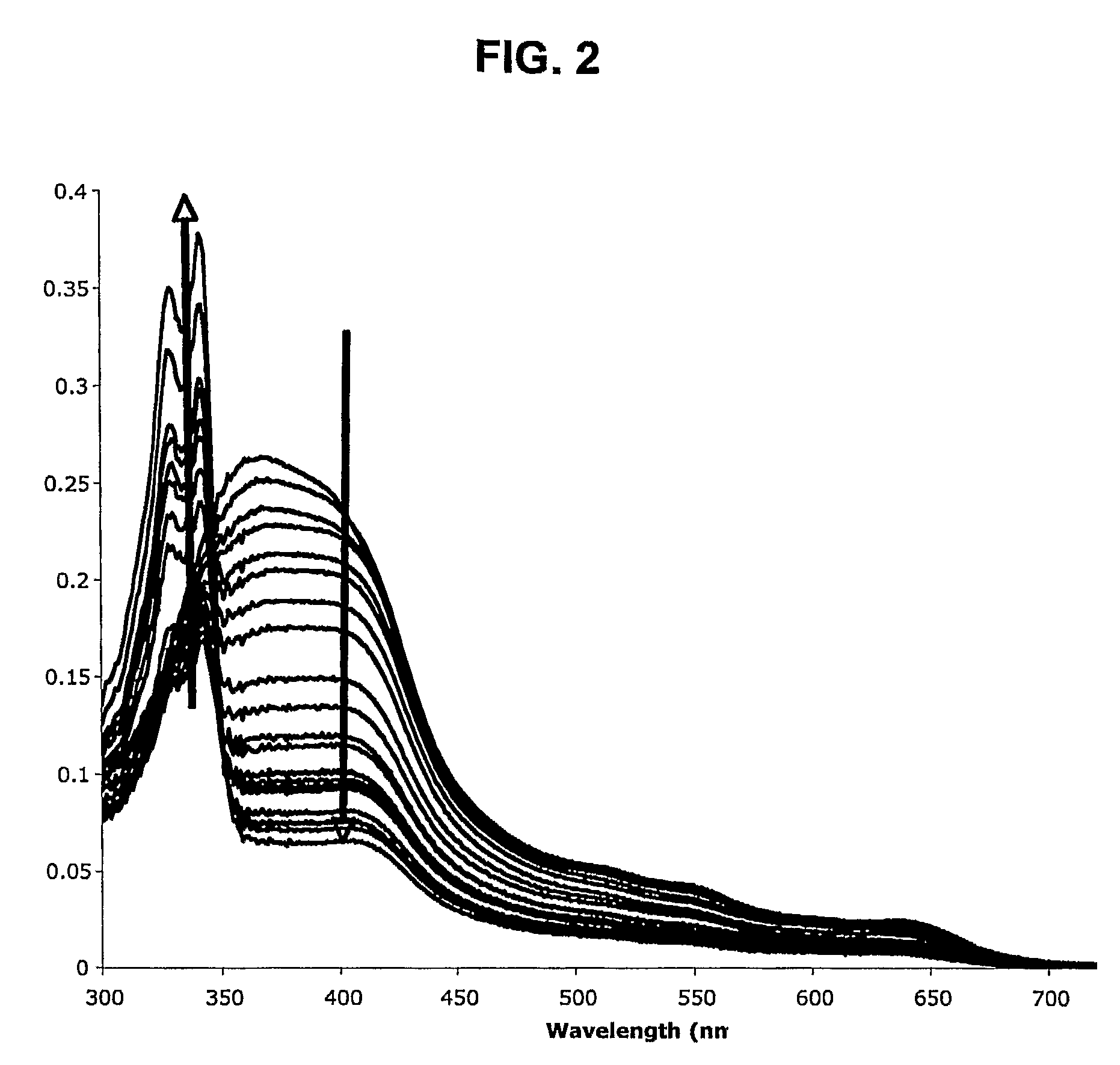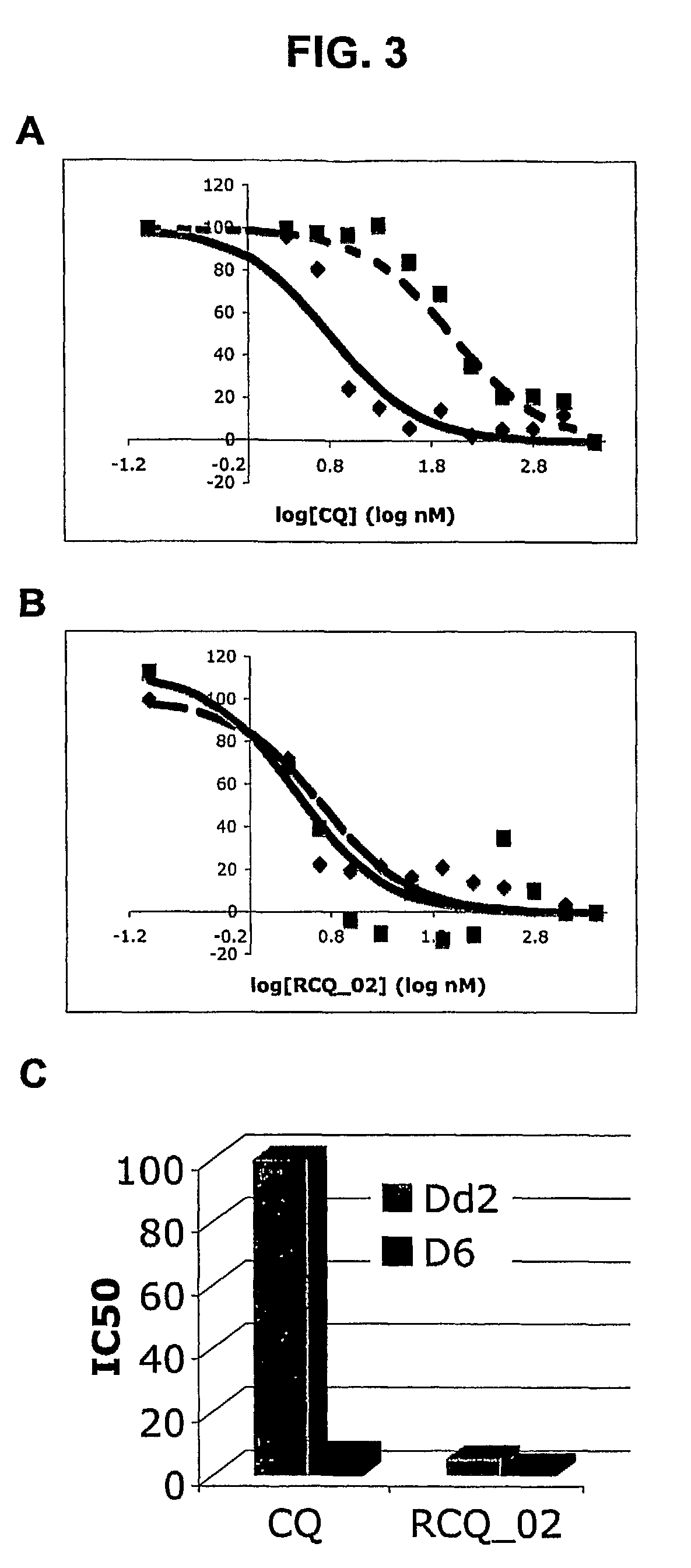Quinoline derivatives and uses thereof
a technology of quinoline and derivatives, applied in the field of quinoline derivatives, can solve the problems of cq being almost useless in malaria treatment, none of these therapies meet cq's simplicity of use and low cost, and achieve the effects of inhibiting the growth of plasmodium sp, high efficacy, and increasing local concentration
- Summary
- Abstract
- Description
- Claims
- Application Information
AI Technical Summary
Benefits of technology
Problems solved by technology
Method used
Image
Examples
example 1
[RCQ—02] is Highly Effective Against CQR and CQS P. falciparium
[0199]This Example illustrates the synthesis of an exemplary RCQ, referred to as RCQ—02 (formally, N′-(7-Chloro-quinolin-4-yl)-N-[3-(10,11-dihydro-dibenzo[b,f]azepin-5-yl)-propyl]-N-methyl-propane-1,3-diamine). RCQ—02 has a 7-chloroquinoline CQ core with the reversal agent, imipramine, substituted for the diethylamino end of the chloroquine side chain. Imipramine was selected as the reversal agent moiety in RCQ—02 because imipramine is synthetically (in fact, commercially) available, symmetric, simple, and conforms to a published reversal agent pharmacophore (Bhattacharjee et al., J. Chem. Inf. Comput. Sci., 42(5):1212-1220, 2002), having the two hydrophobic rings and an aliphatic chain terminating in a positively charged nitrogen. CQ analogs with 3 and 4 carbons in the aliphatic chain are known (e.g., De et al., J. Med. Chem., 41(25):4918-4926, 1998; De et al., Am. J. Trop. Med. Hyg., 55(6):579-583, 1996; Ramanathan-Gi...
example 2
RCQ—02 and CQ have Substantially Similar Electrostatic Potentials and Electron Densities, and RCQ—02 and RCQ—31 Effectively Bind Heme
[0202]This Example illustrates that the covalent coupling of a reversal agent (e.g., imipramine) to CQ does not substantially affect the electrostatic potential or electron density of the CQ moiety, nor affect the ability of the hybrid molecule to interact with heme.
[0203]The GAUSSIAN-03 program (which is publicly available at the website having the address www.gaussian.com) was used to ascertain the charge distribution around CQ and the CQ moiety of RCQ—02. Calculations were performed at the B3LYP / 6-311+g(d) level of theory, and results were visualized with the program gOpenMol (which is publicly available at the website having the address www.csc.fi / gopenmol).
[0204]FIG. 1 shows that the electrostatic potentials and electron densities are nearly identical for the CQ portion of each of these molecules. The same result was obtained for deprotonated quin...
example 3
RCQ—02 is Highly Effective Against CQR and CQS P. falciparum Strains
[0209]This Example demonstrates that RCQ—02 is a highly effective inhibitor of the growth of CQR and CQS P. falciparum strains in vitro.
[0210]An in vitro fluorescence assay for determining IC50 of antimalarial drugs was performed as previously described by Smilkstein et al. (Antimicrob. Agents Chemother., 48(5):1803-1806, 2004). This relatively low-cost procedure can be automated for high-throughput screening of the antimalarial activities of RCQs described herein. Advantageous, this method also allows the tested agent (e.g, a RCQ) to be in contact with the parasite for an entire developmental cycle without purine starvation (which occurs with the commonly used 3H-hypoxanthine method; see, e.g., Desjardins et al., Antimicrob. Agents Chemother., 16, (6):710-7188, 1979).
[0211]Briefly, an initial parasitemia of approximately 0.2% was attained by addition of uninfected red blood cells to a stock culture of cells infecte...
PUM
| Property | Measurement | Unit |
|---|---|---|
| pH | aaaaa | aaaaa |
| pH | aaaaa | aaaaa |
| pH | aaaaa | aaaaa |
Abstract
Description
Claims
Application Information
 Login to View More
Login to View More - R&D
- Intellectual Property
- Life Sciences
- Materials
- Tech Scout
- Unparalleled Data Quality
- Higher Quality Content
- 60% Fewer Hallucinations
Browse by: Latest US Patents, China's latest patents, Technical Efficacy Thesaurus, Application Domain, Technology Topic, Popular Technical Reports.
© 2025 PatSnap. All rights reserved.Legal|Privacy policy|Modern Slavery Act Transparency Statement|Sitemap|About US| Contact US: help@patsnap.com



